Clothing Codes of Antifa and the Alt-Right

The United States of America, 2018: a state of turmoil and uncertainty has gripped the nation. A period of intense polarization coupled with feelings of a directionless future, both at home and abroad, have erupted in protests by both poles of the political spectrum. These are their fashion codes.
Today in America
The United States of America, 2018. A state of turmoil and uncertainty has gripped the nation. A period of intense polarization coupled with feelings of a directionless future, both at home and abroad, have erupted in protests by both poles of the political spectrum.
According to the Southern Poverty Law Center, the alt-right is made up of “a set of far-right ideologies, groups and individuals whose core belief is that ‘white identity’ is under attack by multicultural forces using ‘political correctness’ and ‘social justice’ to undermine white people and ‘their’ civilization. Characterized by heavy use of social media and online memes, Alt-Righters eschew ‘establishment’ conservatism, skew young, and embrace white ethno-nationalism as a fundamental value.”
On the opposite end of the spectrum lies the conglomeration of self-styled, anti fascist groups known as Antifa. The autonomous collection of groups oppose fascism through direct action, including physical violence. They have been known to engage in militant protest tactics in the name of anti-capitalism and anti-fascism. Antifa aims to disrupt white supremacist ideologies directly, rather than politically.
These groups represent the two opposite poles of the ever-widening political spectrum. They are the ultimate extremes of the thinking of two sides trying to win the fight against their opponents, rather than striving for equality through compromise on a common ground. They have very little shared space to swim in, and with no common ground and a lack of verbal communication, physical violence is an inevitability.
Antifa and the alt-right are complex, multifaceted organizations that must be understood. The articulation of these two groups by third parties allows for the mitigation of blindness to their growth and achievement of goals. One shared facet of these groups is the codes behind their fashion choices. In other words, do they have common uniforms? If so, how do these uniforms reflect their ambitions and ideologies?
To date, the strongest example of an eruption of violence between these two groups occurred at the Unite the Right rally in Charlottesville, Virginia in August 2017. The goal of the far-right was to protest the removal of a Robert E. Lee statue from Emancipation Park. The event culminated with a white supremacist, James Fields, ramming his car into a crowd of counter-protesters, killing one and injuring nineteen.
The Alt Right - Blending In
Before the controversial-turned-tragic Charlottesville rally, the members lining up to protest from the alt-right were given a dress code from one of the alt-right’s high profile members, Andrew Anglin. According to Nylon, “Anglin told his followers to look ‘hip,’ ‘sexy,’ ‘dangerous,’ ‘appealing,’ adding: ‘that means you have to go to the gym.’ He told those reading what kind of shirts to wear: ‘The worst look ever is a baggy T-shirt. Wear fitted T-shirts, where the sleeve goes to the middle of your bicep. It should not hang lower than the base of your member.’ ‘We must have Chad Nationalism,’ he noted, referencing a term for bro culture. ‘That is what will make guys want to join us, that is what will make girls want to be our groupies. That will make us look like bad boys and heroes. That is what we are going for here.’”
Clean, preppy and polished. This is the aesthetic of alt-right fashion; they tried to and continue to try to legitimize themselves in terms of fashion. Using a mainstream, ‘bro culture’ style as a tool to disarm skeptics and dissenters (who may have preconceived notions of what white supremacists look like in their heads) is a powerful means to charm and disarm opponents.
Take, for example, Richard Spencer. His well-groomed outfits consist of nice three piece suits, thousand dollar watches and a classic right-wing haircut. If he looked like a slob who wasn’t put together, people wouldn’t take him seriously. Richard Spencer wants to be taken seriously and wearing a suit is an act of image maintenance. He needs to do this so that his views can be further legitimized into the mainstream discourse one step at a time. A mainstream appeal is less threatening to a potential curious-observer-turned supporter. The men in the suits are the ones with enough charms to change minds.
Image Credit: Joe Raedle/Getty Images 2018
Antifa - Preparing for the worst
Antifa takes a different approach when it comes to their fashion codes. Instead of wearing preppy, clean cut outfits to try and legitimize their ideology, they opt for black bloc style clothing, wearing masks and often goggles to anonymize and protect from pepper spray and the sort. On Vice, they quote Mark Bray, author of Antifa: The Anti-Fascist Handbook, and explained "there is no Antifa uniform because it is not an organization, but a range of autonomous groups who are fighting racism around the world...Antifa has no uniform, instead, they adopt a common aesthetic."
According to Vice, “when the media depicts antifa groups dressed in all black, it is because they are using a tactic called "black bloc." Inspired y anarchists, this strategy was adopted by a German Antifa group in the 1970s that would dress in all black, often sporting face coverings like motorcycle helmets or balaclavas. This uniform is meant to create anonymity for those Antifa who were prepared to carry out militant action against fascists. But not everyone at a protest who is wearing black and covering their face is automatically Antifa, as Bray noted. There are plenty of people who dress like that who aren't associated with a group.”
If the alt-right continues to exist and gain ground, Antifa’s goal is to stop the alt-right, even through the use of physical violence.
Image Credit: Mobilus in Mobili/Wiki
Antifa unites under select common symbols that represent their collective beliefs. Two of the most common symbols are the three downward facing arrows of the Iron Front, an anti-Nazi organization in the 1930’s, and the logo of two flags. "The flag logo comes out of Germany and is maybe the most influential symbol," said Bray. "It can be adapted to different kinds of politics and groups whether you have a red flag and a black flag or two black flags, or a purple and black or pink and black flag, as a sort of feminist or queer anti-fascism."
The Fashion Industry's Response
In this era of weaponized fashion, should the industry be doing more to combat it? Arguably, due to the large amount of cultural equity the fashion industry holds, large firms should respond more actively when an event like Charlottesville happens. At its core, the question remains. Should it be incumbent on these large companies to be vocal when a Charlottesville happens? If the companies that “sponsor” white supremacists came out against them, would it have an effect? We’ll have to see what happens in the coming years and try to find a level ground where our societies can at the very least co-exist.









